Any links to online stores should be assumed to be affiliates. The company or PR agency provides all or most review samples. They have no control over my content, and I provide my honest opinion.
Neovide, by The Space is an ambitious smart kitchen appliance that claims to be able to sous vide without the need for water or vacuum packing your food.
When I was approached by The Space about this product, I was immediately excited about it. Ever since reviewing the Anova Sous-Vide Precision Cooker 2.0, I have been sold on sous vide and won’t cook a roast dinner without it. I find it is perfect for large cuts of meat.
After accepting the review offer for Neovide, I started to have some doubts. It seems too good to be true, and I questioned if it could be classed as sous vide or get close to the results from a proper immersion circulator.
Thankfully, the results ended up better than expected. This isn’t a perfect machine, but it has a lot of appeal.
Features / Specification
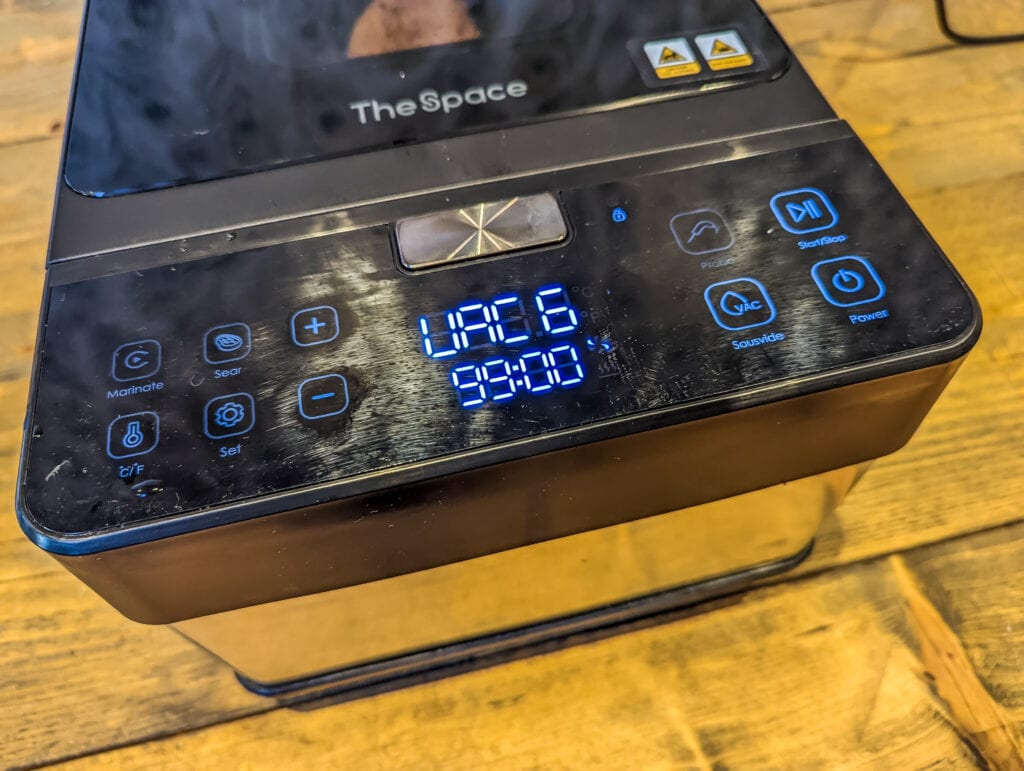
This basically works in a similar way to the Anova Precision Oven, where the meat is held at a very precise temperature that you can’t achieve with a normal oven. With the Anova, they use steam, with this, it uses a vacuum.
Thr blurb from The Space states:
Neovide integrates vacuuming, sous vide and searing into one machine. Place the food in the chamber, set the temperature, press the button, and you are all set. No extra vacuum sealer and water bath are required. You can even sear your food within the chamber.
Thanks to the innovative waterless design, Neovide allows you to check the food temperature in real time with a built-in probe. It offers you truly precise temperature control on the food. No more guessing. Your food will be in the perfect doneness as you expect.
As Neovide offers one-stop sous vide experience, you don’t need to spend your budget on an extra vacuum sealer, vacuum sealer bags, a water bath, or the water. In addition, it also helps reduce your investment on manpower with its easy maintenance feature.
As Neovide uses no water in the process of sous vide, it can heat the chamber up to the desired temperature in 5 minutes which saves you a huge amount of time.
It is worth noting that you are not the only time from not having to vacuum seal your food, but you are reducing plastic waste and reducing upfront costs by not having a vacuum sealer and ongoing costs of the plastic bags.
I hate my vacuum sealer, it wasn’t even particularly cheap either, which is what made the Neovide so appealing for me.
Neovide NSV100 vs NSV500
I was sent the Neovide NSV100, which has a capacity of just 3L; however, they have a larger NSV500 model which has a 8.6L.
As I was sent an early review sample, my model uses US voltages, but the specification mentions EU, so I assume there will be a 220v model as well.
- Sous vide temperature: 20℃ – 95℃ (68℉ – 194℉)
- Probe (food core) temp accuracy: ±0.1 ℃/℉
- Sear temperature: 150℃ – 210℃ (302℉ – 410℉)
- Marinate: 1 – 10 cycles, 5 – 50 min/cycle
- Chamber volume:
- NSV100: 3L
- NSV500: 8.6L
- Heater power
- NSV100: 700W
- NSV500: 1000W
- Body Dimensions:
- NSV100: 467 mm (D) x 263 mm (W) x 208 mm (H) 18.39″ (D) x 9.17″ (W) x 8.19″ (H)
- NSV500: 587 mm (D) x 343 mm (W) x 294 mm (H) 23.11″ (D) x 13.50″ (W) x 11.57″ (H)
- Chamber Dimensions:
- NSV100: 260 mm (L) x 180 mm (W) x 65 mm (D) 10.24″ (L) x 7.09″ (W) x 2.56″ (D)
- NSV500: 380 mm (L) x 260 mm (W) x 90 mm (D) 14.96″ (L) x 10.24″ (W) x 3.54″ (D)
Is this sous vide?
This will likely be a contentious issue. In my opinion, strictly speaking, this is not sous vide. This is highlighted by the fact that when you cook a larger piece of meat, they suggest you wrap it in foil.
From the Neovide FAQ:
Neovide’s heating method is to transfer heat to food through the principle of electromagnetic heating. However, unlike the induction cookers on the market, the heating of the induction cookers is generally fierce until the target temperature is reached. On the basis of the previous test data (experience data), we collect the temperature (actual data) of one or more temperature sensors in the chamber, and to have a comprehensive result to determine how to control the heating of the electromagnetic coil in the next step, through the non-full power pulsed heating, the temperature can reach the target value smoothly, and the precise temperature control similar to the heating of water circulation can be achieved.
So, it is basically an Induction hob turned into an oven but with very precise heat measurements allowing it to stay at a stable temperature. I assume the vacuum seal will contain moisture that is evaporated from the meat reducing the chance it will dry out. This is also why you need the foil for longer cooks because the vacuum-sealed chamber is not as sealed as vacuum sealing the food itself.
In comparison, the Anova Precision Oven introduces steam into the oven to prevent drying out. I would have thought that long cooks using this method would strip away some of the flavours, but I have not used the Anova oven, so can’t confirm.
Probe mode
One unique feature that the Neovide has is the probe, something that is not possible with normal sous vide.
With this mode, you can set the desired temperature of the meat, and it will cook it until it hits that temperature.
I have played around with this, but it has limited appeal to me. The appeal of sous vide is to be able to walk away and forget about it. If you only want to cook the food until the point of pasteurisation, then this is a useful tool to have.
I normally prefer cooking longer than the bare minimum to allow the meat to tenderise, though I mainly only cook joints and haven’t experimented a lot with steak.
App

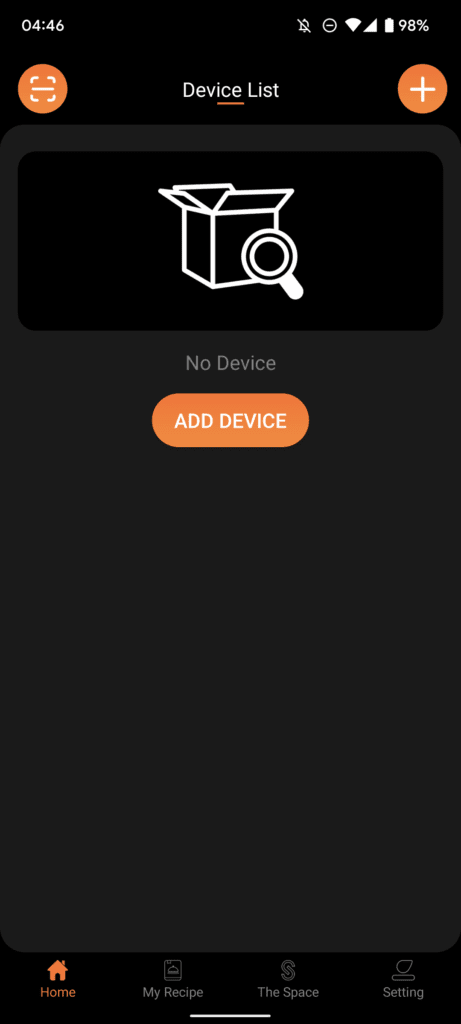


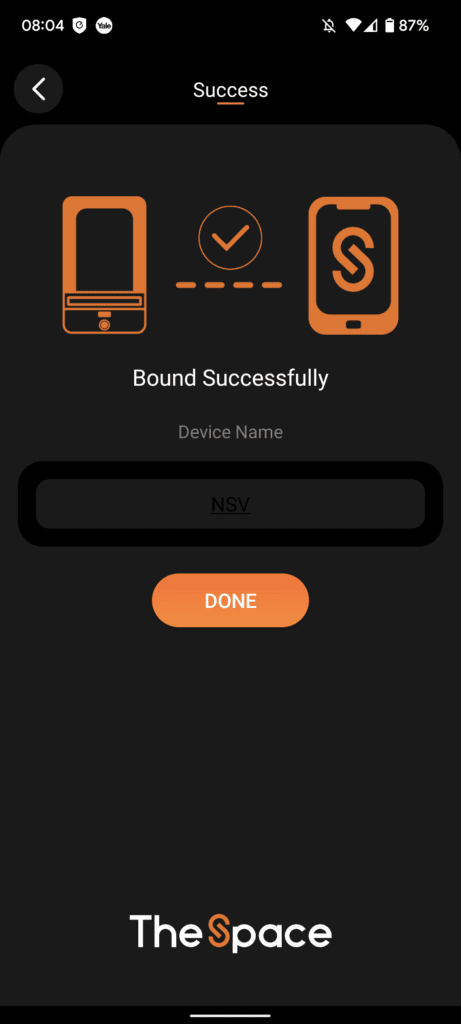
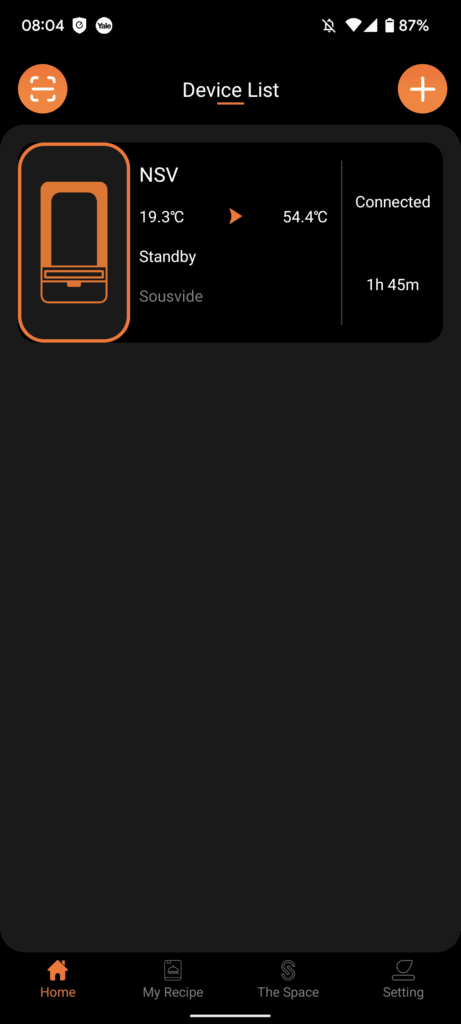
I struggled to find the app when I first started using this, because the product is so new. So most of my cooks were done using the manual controls. It was easy to do manually, and it is also easy to do via the app. The app is very basic, but you can monitor and control things remotely, similar to the Anova, which can be handy.
You can download the Android app here.
In Use
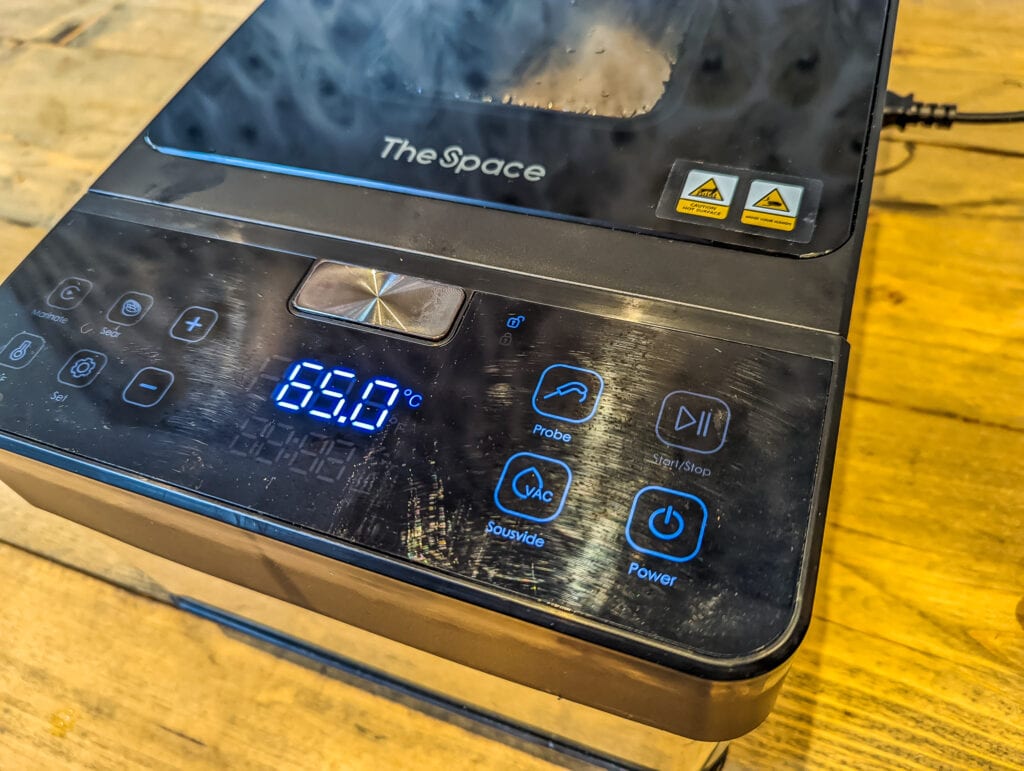
I have only had Neovide for a couple of weeks. I haven’t cooked lots of exciting meals with it. I kept everything simple. For my initial tests, I used cheap meats from the supermarket. My pictures may not look as impressive as a food blogger, but I was more interested in the quality of the cook, not making an Instagram-able meal.
You will notice my smart meter on the side too. With the insane price of electricity, I am conscious of the running costs of the devices I review. I didn’t test this with a smart plug because it was a US plug, though I could have tested it at the wall through the transformer. However, it appeared to use no more than the Anova when in use. Depending on the temperature of your water when you add it, the Anova could potentially use quite a lot of electricity with the initial heat.
Sous Vide Chicken

The chicken and steak were both cooked without using the app. The on-display controls are very easy, and I’d say you don’t really need the app.
I started off with chicken breast as it is about as cheap as you can get, and I didn’t care if I ruined it. It was just basically seasoned.
The Neovide comes with a very basic recipe booklet and suggests cooking the chicken at 65°C for an hour.
With this, I used the searing mode, and it performed well. It takes a while for the temperature to get high enough for a sear, so you need to take the meat out first. As I have a big gas range cooker, for future cooks, I just seared the meat in a stainless steel frying pan. I appreciate the benefit of an all-in-one system, but I found it a bit quicker on gas.
The end result was good, nothing exciting, but it was moist, tender chicken that was cooked through properly
I always overcook my chicken breast when oven cooking or pan frying due to fear of undercooking, so the Neovide works well here, and less messing around with vacuum sealing.
Sous Vide Steak
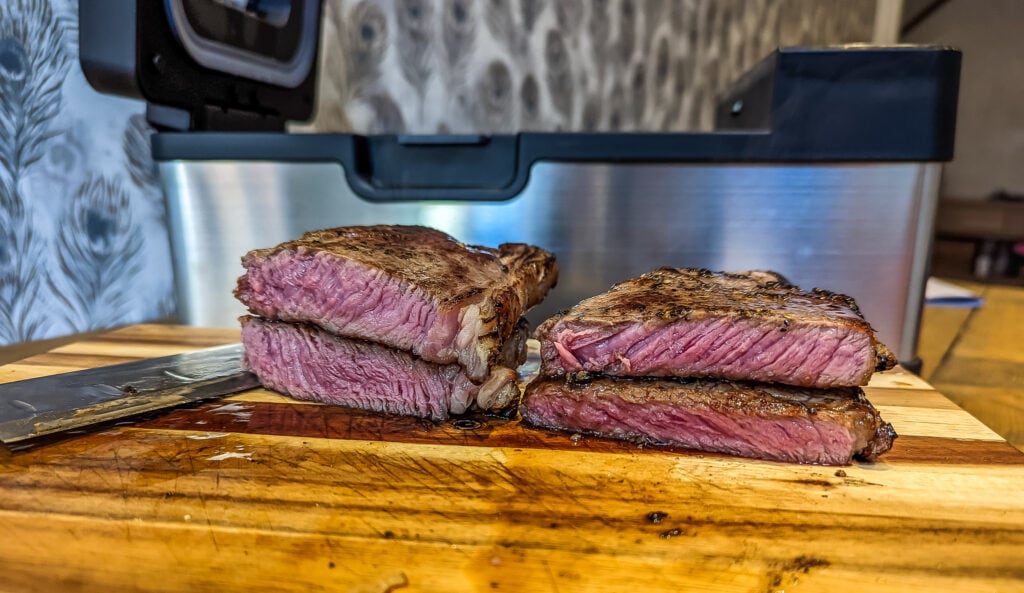
For the steak, I bought two and did one in the Anova and the other with Neovide.
I went with mediocre quality Sainsbury’s Taste the Difference 225g sirloin steak. They looked reasonably thick in the pack, but in hindsight, I should have forked out more for the thick cut or just gone to a butcher. I was cooking for myself and didn’t really fancy eating a kilogram of meat to myself or the expense of it.
The seasoning was basic, and both were finished off in a frying pan.
The thinner steak on the right is the Neovide, and on the left is the Anova.
The Anova appears more evenly cooked, but the overall results for both steaks were good. I think I actually preferred the taste and tenderness of the Neovide.
Sous Vide Roast Beef
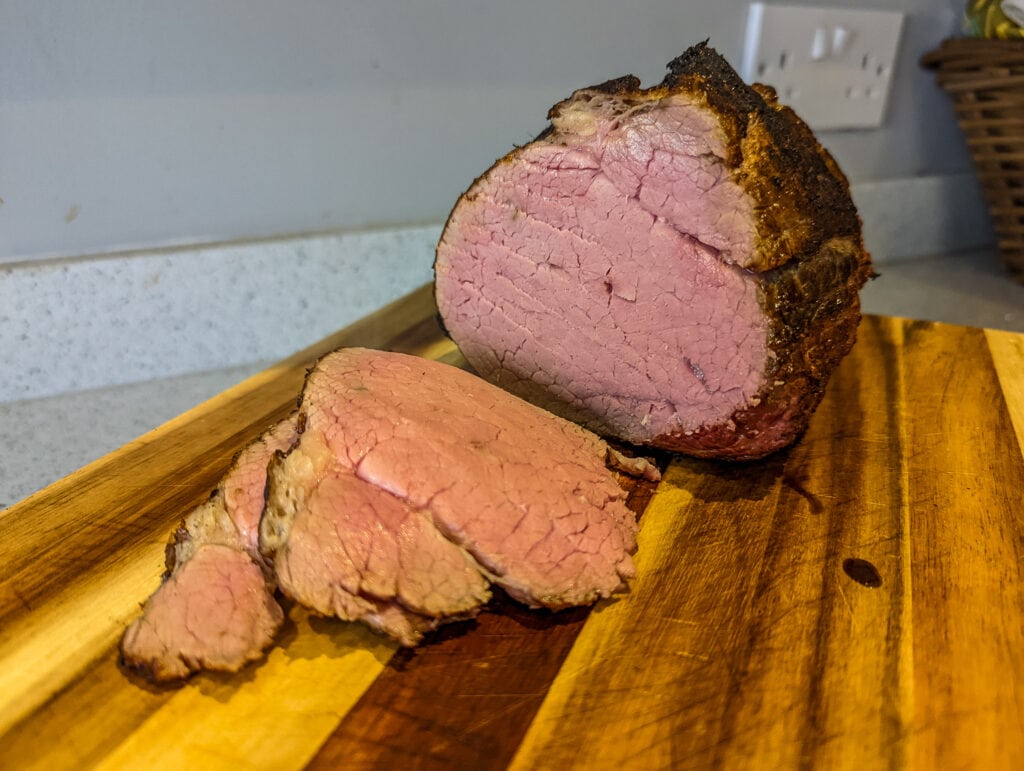
Because the steak didn’t appear to be as evenly cooked as the Anova and the requirement to wrap larger cuts of meat in tin foil, I had very low expectations with cooking a joint of beef.
Again, this is a cheap cut of silverside from Sainsbury’s, which I think is the bottom round for US readers. It was a small joint; again, I was eating it myself, and I was also aware of the space limitations of the Neovide.
It fit perfectly well, just touching the glass, and I could have got a much larger family-sized joint as they are normally elongated.
I cooked this based on an Anova bottom round beef roast guide, which is 54.5°C (130°F) for 24 hours. I then finished off in the pan.
The tin foil contained a lot of myoglobin juice, when the cook finished. I had to drain the contents just as I would with a vacuum bag.
My pictures don’t do it justice, it looks kind of pale, it didn’t seem to look like that in real life, I don’t think my lighting did it justice. However, the cook was even, and the meat was tender without being dry.
I was quite surprised at how good this tasted, as I was not expecting good results at all. It also reminded me that sous vide could make a decent meal out of poor-quality meat.
Price and Alternative Options
The Neovide is now live on Kickstarter. The RRP for the Neovide NSV100 is $419 and the NSV500 is $699.
They state early bird pricing is $249 in the text, but it seems to be $350 (about £216) and there is $45 shipping to the UK.
| Preview | Product | Rating | Price | |
|---|---|---|---|---|
![Anova Precision Cooker 2.0 [AN500-UK00], Sous Vide, WiFi,...](https://m.media-amazon.com/images/I/41UxQOxIydL._SL160_.jpg)
| Anova Precision Cooker 2.0 [AN500-UK00], Sous Vide, WiFi,... | £289.99 | Buy on Amazon | |

| Inkbird ISV-100W Sous Vide WiFi Cooker Immersion Circulator,... |
£89.99 | Buy on Amazon |
The Anova Precision Cooker is £220, but then you also need a big pot or sous vide container, a vacuum sealing, and vacuum bags.
Anova also has the Precision Oven at £599, which also claims to do sous vide without a bag and can be done in wet or dry modes. While this also appears to be using the term sous vide loosely, it is still possible to cook meat using vacuum bags in wet mode. This has a 40L capacity and can cook in multiple modes, not just sous vide. This includes steam, convection bake, bake, air fry, proof, broil/grill, toast and more.
The Inkbird ISV-100W looks like an excellent cheap smart sous vide alternative at just £86.
Overall
I have some mixed feelings about Neovide, but at the end of the day, I have been happy with the results. My roast beef was delicious, and that’s all that is important to me.
I don’t think you can strictly call this a sous vide, and having to wrap larger pieces of meat in tin foil is confirmation that this is not sous vide machine. But the important thing is that the end result is more or less what you achieve with a sous vide.
I think my main issue with the Neovide is that it is a physically large appliance with limited capacity. You can fit a medium-sized joint of beef off the bone, but that’s about it. You are not going to get anything fancy with a bone in there. Nor are you going to squeeze in more than two steaks. They will have the 8L version, but this will increase the footprint of the Neovide by around 25%, and it is already quite large.
For a single person or a couple, I think this should work well. In this scenario, I think it could be excellent, and I’d be tempted to continue using it myself if it was on a UK plug. I never bother with small cuts of meat with normal sous vide, I just find it a bit of a faff. But with this, I don’t think it could be any easier.
Overall, if you are happy with the capacity limitations and have the counter space, this is an excellent alternative to sous vide.
The Space Neovide Sous Vide Cooker Review Rating
Summary
I have come away impressed with the Neovide. It may not strictly be sous vide, but the end result is good enough for me. There is less prep time, less plastic waste, and the food is delicious. The main downside is that this is physically a large appliance yet has quite a small capacity of 3L.
Overall
85%-
Overell - 85%85%
Pros
- Easier to use than a immersion circulator sous vide
- Less prep work and no need to buy a vacuum sealer
- No plastic waste from bags
Cons
- Large appliance with relatively small capacity
I am James, a UK-based tech enthusiast and the Editor and Owner of Mighty Gadget, which I’ve proudly run since 2007. Passionate about all things technology, my expertise spans from computers and networking to mobile, wearables, and smart home devices.
As a fitness fanatic who loves running and cycling, I also have a keen interest in fitness-related technology, and I take every opportunity to cover this niche on my blog. My diverse interests allow me to bring a unique perspective to tech blogging, merging lifestyle, fitness, and the latest tech trends.
In my academic pursuits, I earned a BSc in Information Systems Design from UCLAN, before advancing my learning with a Master’s Degree in Computing. This advanced study also included Cisco CCNA accreditation, further demonstrating my commitment to understanding and staying ahead of the technology curve.
I’m proud to share that Vuelio has consistently ranked Mighty Gadget as one of the top technology blogs in the UK. With my dedication to technology and drive to share my insights, I aim to continue providing my readers with engaging and informative content.
Last update on 2024-04-18 / Affiliate links / Images from Amazon Product Advertising API

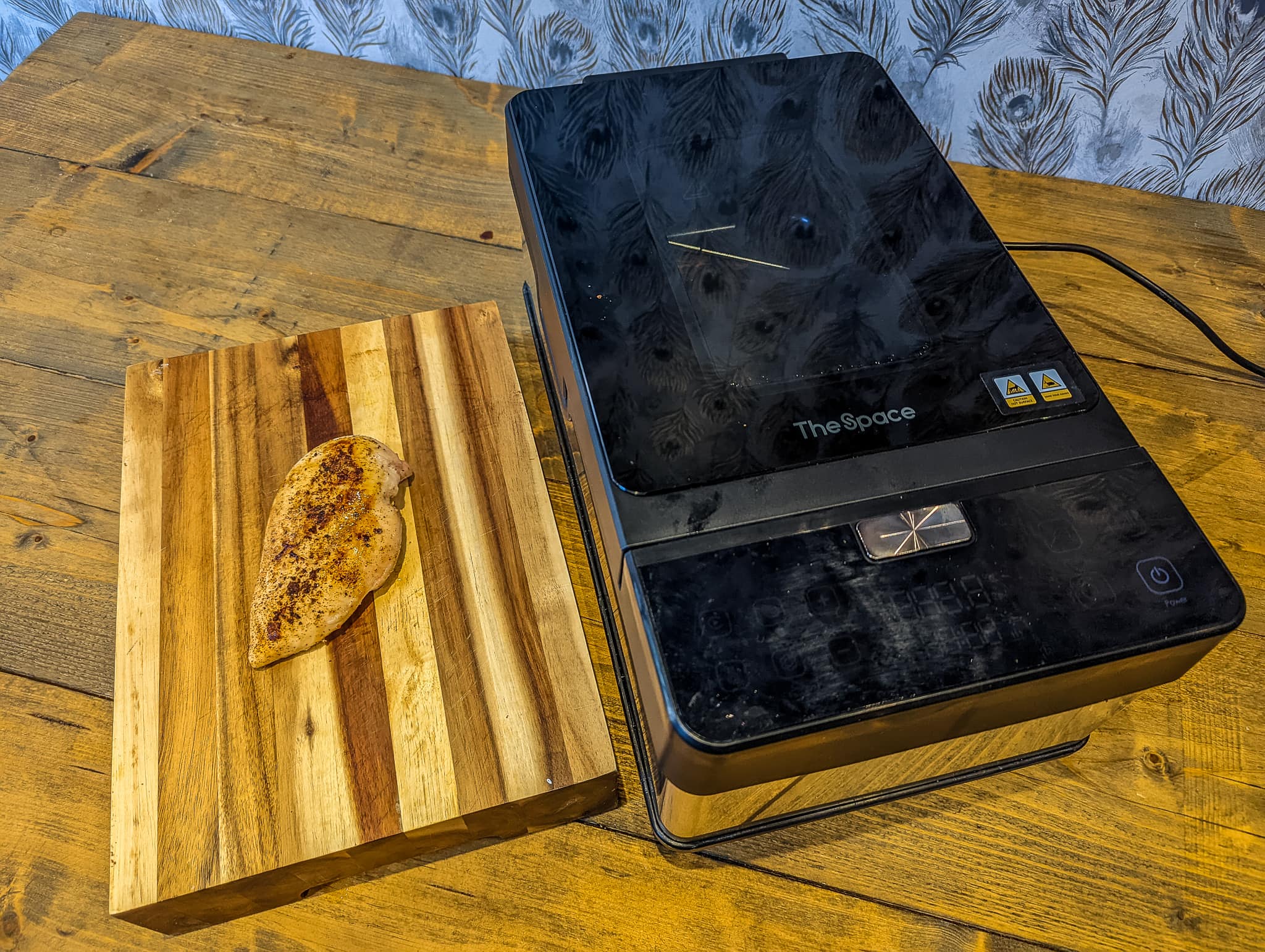

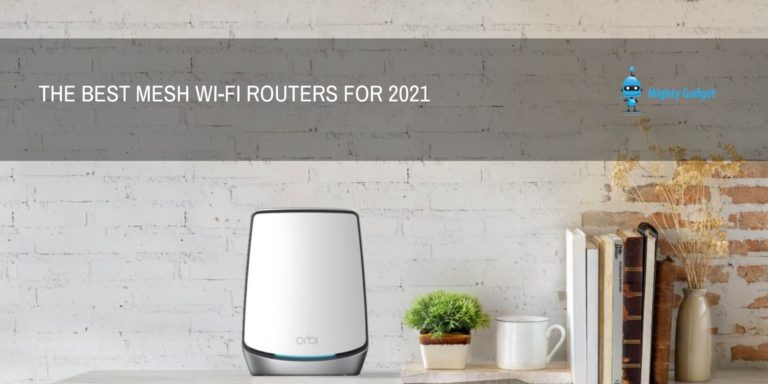

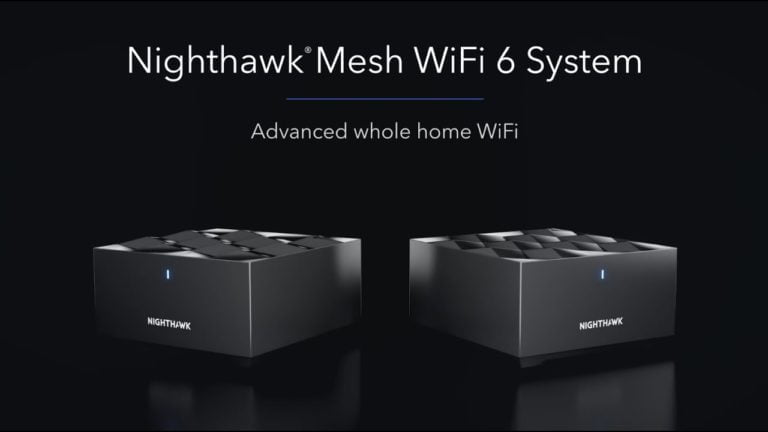
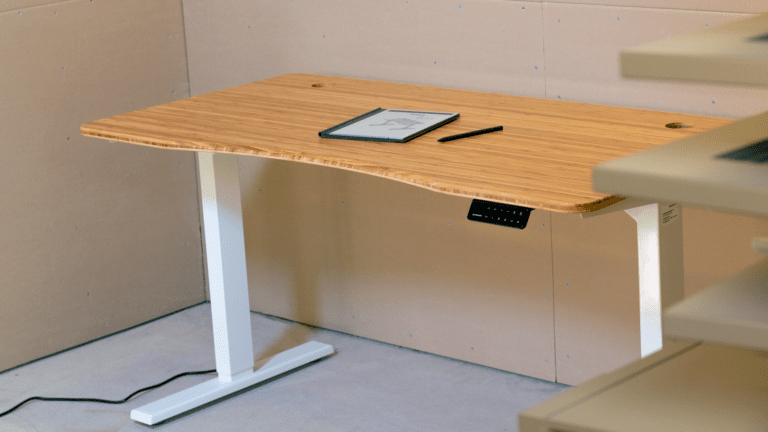
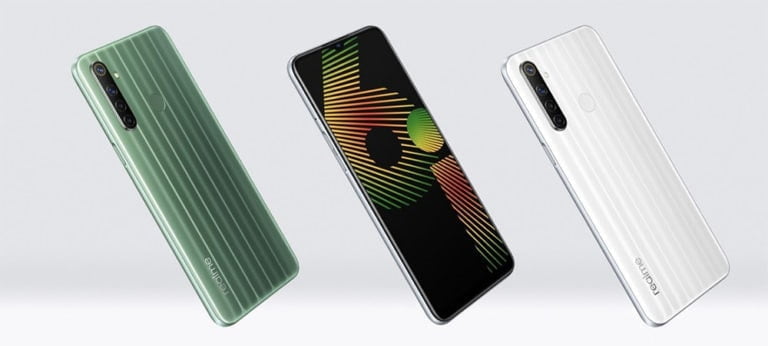
I am 69 and divorced. The Neovide is the best thing I’ve ver bought. It is perfect for my needs and although you can buy cheap cuts of meat for example, when you want a filet mignon this gives the most mouth-watering results every time – I’ve never had more tender and moist food in my life! I have perfected my own recipes through trial and error and have them stored in the app on my phone. I never use the sear mode, preferring a 2 minutes per side high-heat sear to finish off my steaks, chicken, or whatever I’ve cooked. The water bath mode is great for hot dogs, poached eggs to die for, and lots more. Since sous vide is French for under vacuum I think it is true sous vide by the way.